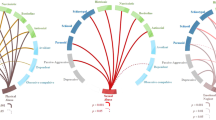Abstract
Multivariate clustering procedures were used to identify homogeneous subgroups of outpatient sex offenders against children (n=110)on the basis of the Minnesota Multiphasic Personality Inventory (MMPI). Results indicated a five-subgroup solution. Two within-normal-limits and two clinically elevated profile subgroups replicated subtypes found in previous cluster analytic studies of child sex offenders. The fifth subgroup appeared similar in MMPI profile pattern and elevation to a previously identified subtype of rapists. Discriminant analyses showed that subgroups differed along dimensions of cognitive disturbance and sexual functioning. Furthermore, levels of psychopathology corresponded with levels of sexual pathology. Results are discussed with reference to previous MMPI cluster analytic studies of sex offenders and theories of sexual aggression.
Similar content being viewed by others
References
Becker, J., & Kaplan, M. (1990). Assessment of the adult sex offender. In P. Reynolds, J. Rosen, & G. Chelune, (Eds.),Advances in psychological assessment, Vol. 7 (pp. 261–283). New York: Plenum Press.
Dahlstrom, W. G., Welsh, G., & Dahlstrom, L. (1972).An MMPI handbook; Vol. I. Clinical interpretation. Minneapolis: University of Minnesota Press.
Derogatis, L. (1978).Preliminary manual for the Derogatis Sexual Functioning Inventory.
Duckworth, J., & Anderson, W. (1987).MMPI interpretation manual for counselors and clinicians. Muncie, IN: Accelerated Development.
Duckworth, J., & Barley, W. (1988). Within-normal-limit profiles. In R. Greene,The MMPI: Use with special populations. Philadelphia, PA: Grune and Stratton.
Duthie, B., & McIvor, D. (1990). A new system for cluster-coding child molester MMPI profile types.Criminal Justice and Behavior, 17, 199–214.
Dwyer, M., Metz, M., & Coleman, E. (1990). Sexual offender and sexual compulsive patients: A comparative study.American Journal of Preventive Psychiatry and Neurology, 2, 33–35.
Erickson, W., Luxenberg, M., Walbeck, N., & Seely, R. (1987). Frequency of MMPI two-point code types among sex offenders.Journal of Consulting and Clinical Psychology, 55, 566–570.
Finkelhor, D. (1984).Child sexual abuse: New theory and research. New York: Free Press.
Frost, L., & Chapman, L. (1987). Polymorphous sexuality as an indicator of psychosis proneness.Journal of Abnormal Psychology, 96, 299–304.
Golden, R., & Meehl, P. (1979). Detection of the schizoid taxon with MMPI indicators.Journal of Abnormal Psychology, 88, 217–233.
Graham, J. R. (1987).The MMPI: A practical guide, 2nd ed. New York: Oxford University Press.
Hall, G., Maiuro, R., Vitaliano, P., & Proctor, W. (1986). The utility of the MMPI with men who have sexually assaulted children.Journal of Consulting and Clinical Psychology, 54, 111–112.
Henderson, M. C., & Kalichman, S. C. (1990). Sexually deviant behavior and schizotypy: A theoretical perspective with supportive data.Psychiatric Quarterly, 61, 273–284.
Hoch, P., & Cattell, J. (1959). The diagnosis of pseudoneurotic schizophrenia.Psychiatric Quarterly, 33, 17–43.
Kalichman, S. C. (1990). Affective and personality characteristics of replicated MMPI profile subgroups of incarcerated adult rapists.Archives of Sexual Behavior, 19, 443–459.
Kalichman, S., & Henderson, M. (1991). MMPI profile subtypes of non-incarcerated child molesters: A cross-validation study.Criminal Justice and Behavior, 18, 379–396.
Kalichman, S., Henderson, M., Shealy, L., & Dwyer, M. (1992). Psychometric properties of theMultiphasic Sex Inventory in assessing sex offenders.Criminal Justice and Behavior, 19, 384–396.
Kinder, B. N., Curtiss, G., & Kalichman, S. (1991). Cluster analyses of headache patients' MMPIs: A cross-validation study.Psychological Assessment: A Journal of Consulting and Clinical Psychology, 3, 226–231.
Levin, S., & Stava, L. (1987), Personality characteristics of sex offenders: A review.Archives of Sexual Behavior, 16, 57–79.
Meehl, P. E. (1962). Schizotaxia, schizotypy, schizophrenia.American Psychologist, 17, 827–838.
Meehl, P. E. (1989). Schizotaxia revisited.Archives of General Psychiatry, 46, 935–944.
Miller, H. R., Streiner, D., & Kahgee, S. (1982). Use of the Golden-Meehl indicators in the detection of schizoid-taxon membership.Journal of Abnormal Psychology, 91, 55–60.
Meyer, R. (1989).The clinician's handbook, 2nd ed. Needham Heights, MA: Allyn and Bacon.
Nichols, D. S., & Jones, R. F. (1985). Identifying schizoid-taxon membership with the Golden-Meehl MMPI items.Journal of Abnormal Psychology, 94, 191–194.
Nichols, H., & Molinder, I. (1984).Manual for the Multiphasic Sex Inventory. Criminal and Victim Psychology Specialists, 437 Bowes Drive, Tacoma, WA 98466.
Panton, J. (1979). MMPI profile configurations associated with incestuous and non-incestuous child molesting.Psychological Reports, 45, 335–338.
Quinsey, V. L., Arnold, L., & Pruesse, M. (1980). MMPI profiles of men referred for pretrial psychiatric assessment as a function of offense type.Journal of Clinical Psychology, 36, 410–416.
Romesburg, H. C. (1984).Cluster Analysis for Researchers. Belmont, CA: Wadsworth.
Rosenberg, R., & Knight, R. (1988). Determining male sexual offender subtypes using cluster analysis.Journal of Quantitative Criminology, 4, 383–410.
SAS (1985).User's guide: Statistics, 5th ed. Carey, NC: SAS Institute, Inc.
Shealy, L., Kalichman, S., Henderson, M., Szymanowski, D., & McKee, G. (1991). MMPI profile subtypes of incarcerated sex offenders against children.Violence and Victims, 6, 379–396.
Author information
Authors and Affiliations
Rights and permissions
About this article
Cite this article
Kalichman, S.C., Dwyer, M., Henderson, M.C. et al. Psychological and sexual functioning among outpatient sexual offenders against children: A Minnesota Multiphasic Personality Inventory (MMPI) cluster analytic study. J Psychopathol Behav Assess 14, 259–276 (1992). https://doi.org/10.1007/BF00962632
Accepted:
Issue Date:
DOI: https://doi.org/10.1007/BF00962632



